ISSN ONLINE(2319-8753)PRINT(2347-6710)
ISSN ONLINE(2319-8753)PRINT(2347-6710)
| Jagadeshan G, Anandasabari K, Poornavel S Department of Geology, Anna University, Chennai, India |
| Related article at Pubmed, Scholar Google |
Visit for more related articles at International Journal of Innovative Research in Science, Engineering and Technology
Groundwater has now become a vital source of water for domestic and agricultural activities all over the world. The objective of the present study aims to investigate the groundwater quality of Kosasthalaiyar river basin Tiruvallur district, Tamil Nadu. As a part of the study, 20 groundwater samples were collected for which the in-situ physicochemical parameters were analysed such as pH, EC, TDS and temperature was analysed. The study region underline by archaean crystaline rocks and sedimentary rocks. Geomorphologically most of the study region is covered by alluvial plain and pediplain. Groundwater level was measured for all the 20 wells. Groundwater level was fluctuated from 3 to 8m from surface. Most of the groundwater samples were alkaline nature. The EC ranges from 700 to 2,400 μS/cm. The present study shows that 95% of the sample falls within BIS (2012) permissible limit of TDS which may be employed for consuming without the risk
Keywords |
| Kosasthalaiyar River basin, Water level, well depth, agricultural, Total dissolved solid |
INTRODUCTION |
| Groundwater is mankind's most important, yet most misunderstood, mineral resource. At present one fifth of all the water used in the on earth is acquired from groundwater resources. Even though water resources of the planet earth are abundant, availability of water resources of useful quality of water are limited. The reduction of perennial water resources has been paving way to groundwater to be an important part of groundwater needs. Groundwater supplies are usually free from suspended and organic impurities as a result of natural filtration characteristics of subsurface materials, unlike surface water which will be usually loaded with suspended solids and natural matter. Groundwater also has a more consistent physical and chemical quality unlike surface water. The issue of assessing the groundwater resources as related to its evaluation, development and management is also more complicated in case of hard rock aquifers. The rapidly rising population, urbanization, industrialization and needs for food safety results in unsustainable groundwater development and management which results in deterioration of groundwater in terms of quality and quantity [1]. The groundwater quality, mainly governed by the degree and composition of dissolved solids, is of good significance in deciding its suitability for consuming purpose. Under natural conditions, the spatial and temporal variations in the composition of groundwater depend on rainwater, soil strata, and aquifer materials [2]. The variations the groundwater quality is because of rock–water interaction and oxidation–decrease reactions during percolation of water through aquifers [3,4]. Leaching of salts, ion-exchange process, and residential time of groundwater in the aquifers cause hydrogeochemical variations in groundwater [5] |
| In India, this percentage is significantly larger and dependence on groundwater more pronounced. At present almost 50% irrigated agriculture is dependent on groundwater resources. The urban aquifers are the only natural resource for drinking water supply, they are often perceived as of lesser relevance for the drinking water supply, resulting in crisis in terms of drinking water scarcity, becoming increasingly polluted thereby decreasing their portability [6,7]. Once contamination of groundwater in aquifers occurs by means of the shape of industrial activities and urban growth, it persists for more than 100 years due to very slow movement of water in them and prompts investigations on their quality [8]. The concentration of several inorganic and organic substances beyond the acceptable range causes an adverse effect on human health. Systematic evaluation of groundwater quality is therefore essential for meeting the raising drinking water need and essential for optimal usage of available groundwater on a sustained basis. |
| Numerous workers in India have carried out intensive studies on water quality on diverse tenacities and have implemented innumerable solutions [9, 10, 11, 12]. Chennai is the one of the largest city in India. The different sources of drinking water supply to the Chennai City include large surface but shallow reservoirs, groundwater abstracted from Araniar and Kosasthalaiyar River Basin and southern coastal aquifers, and surface water transfer as a part of inter basin development from Srisailam Reservoir in Andhra Pradesh to Poondi Reservoir of Tamil Nadu. The groundwater quality of Kosasthalaiyar river Basin is dependent on geology, climate, rainfall and topography. Its evaluation is therefore essential to determine its suitability for drinking purpose. The objective of this study is to assess groundwater quality of Kosasthalaiyar River basin, Thiruvallur district, Tamil Nadu and India |
MATERIAL AND METHODS |
| The Kosasthalaiyar river basin (Fig. 1) extends over an area of 3625 km2, in the northernmost part of Tamil Nadu. This is a west to east flowing river, starting from the mountainous terrain in the west and reaching the Bay of Bengal in the east. It has several tributaries, particularly in the western regions. The river is basically ephemeral in nature flowing only during a part of the year generally in the period of November to February. Several reservoirs have been constructed across the river such as Poondi, which impounded the flood waters. In fact, the river flow is a major source of water to the city of Chennai. Rainfall being the only source of water in the area, the amount of rainfall received is of utmost importance in evaluating groundwater resources. The average rainfall in the basin varies from about 530 mm to 1430 mm. |
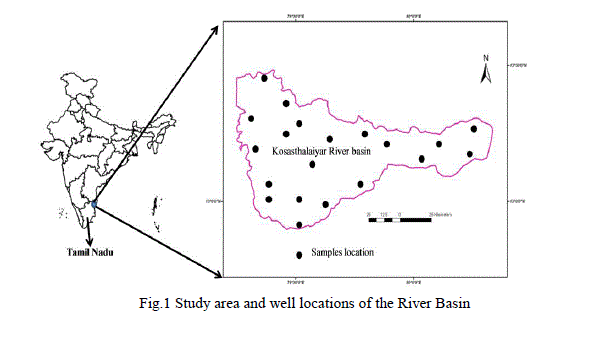 |
| The Kosasthalaiyar river basin has a varied geology. The western part is underlain by hard crystalline rocks (Precambrian) while the eastern part contains sedimentary rocks, alluvium and Laterite. Numerous dolerite dyke is traversing in western part of study area. Laterite rocks are present in the north eastern portion, while calcareous gritty sandstone and clay is present in the central and eastern portion, Alluvium in the predominant formation along the river course. The various geological formations in the area are shown in Figure 2. |
| The study area is basically covered by pediplains, alluvial plains, coastal plains, denudational hills, floodplains, and structural hills (Fig. 3) out of these, the central portion of the study area, is dominated by the pediplains, with a patch of it extending in the north eastern portion. Alluvial plains extend in the north eastern region and in the southern portion. Coastal plains are present in the extreme north eastern portion along the basin boundary patches of denudations hills are present in the central and eastern portion, flood plains stretch in the central and north east portion and small patches of structural hills are present in the north west portion of the study area. |
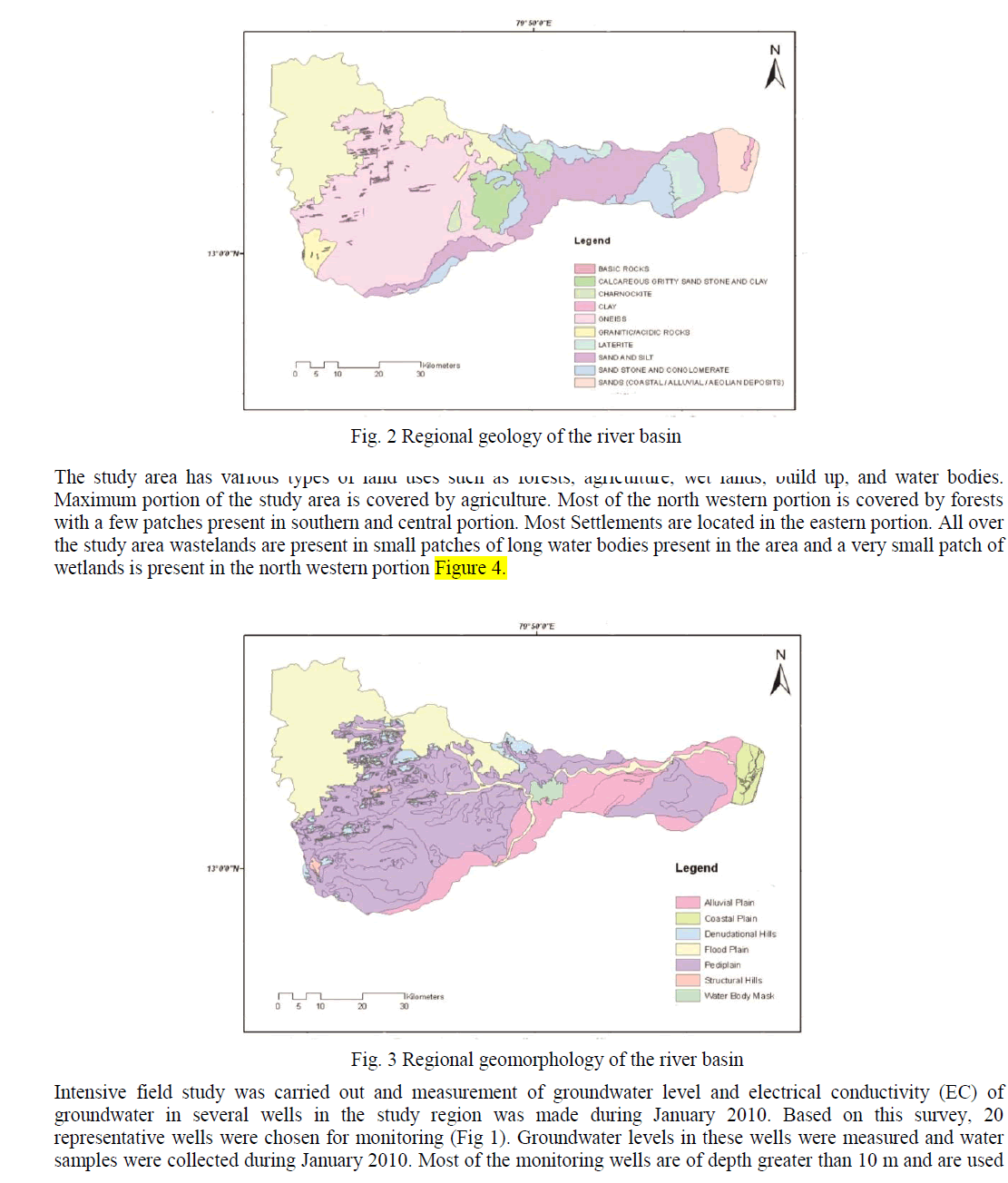 |
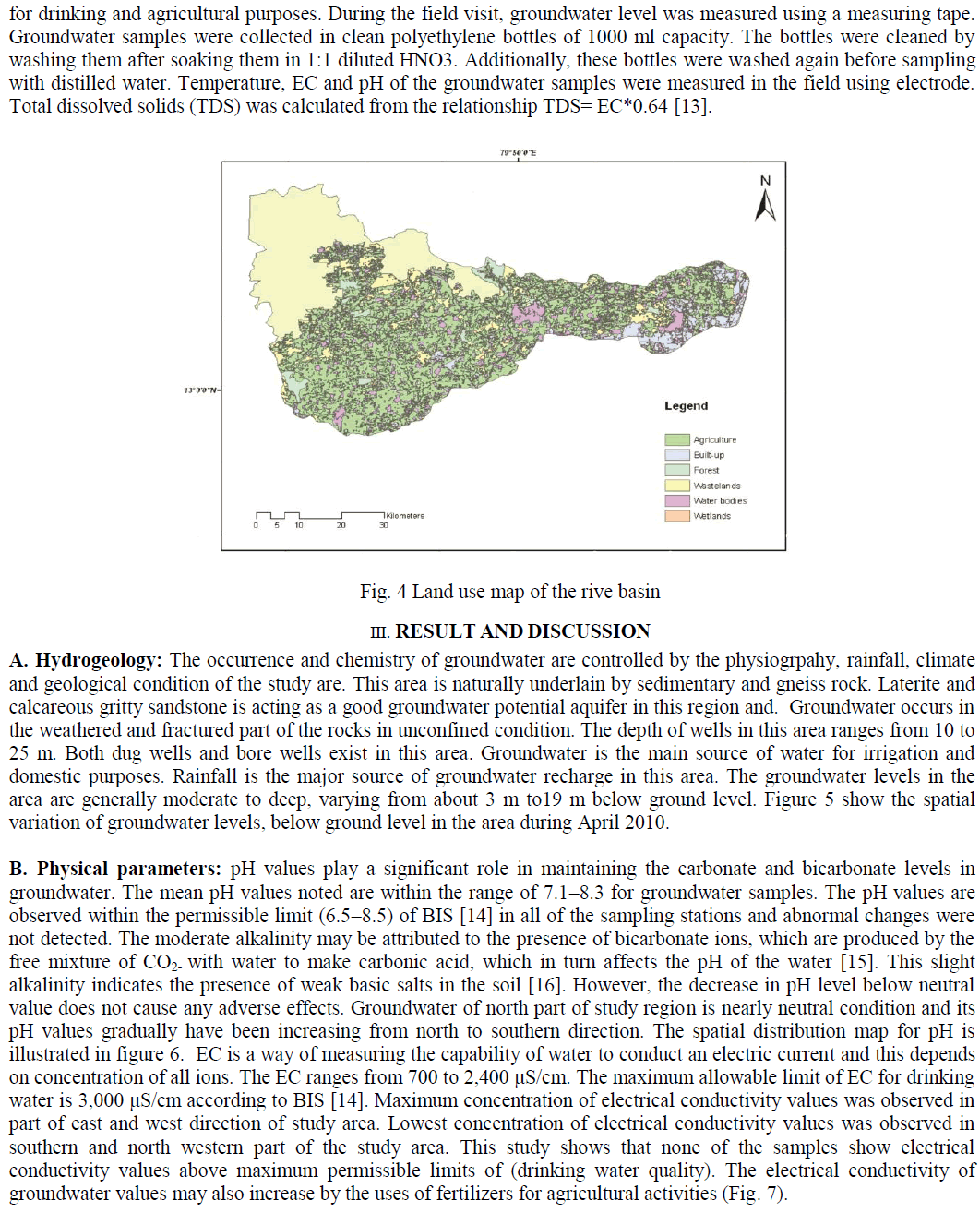 |
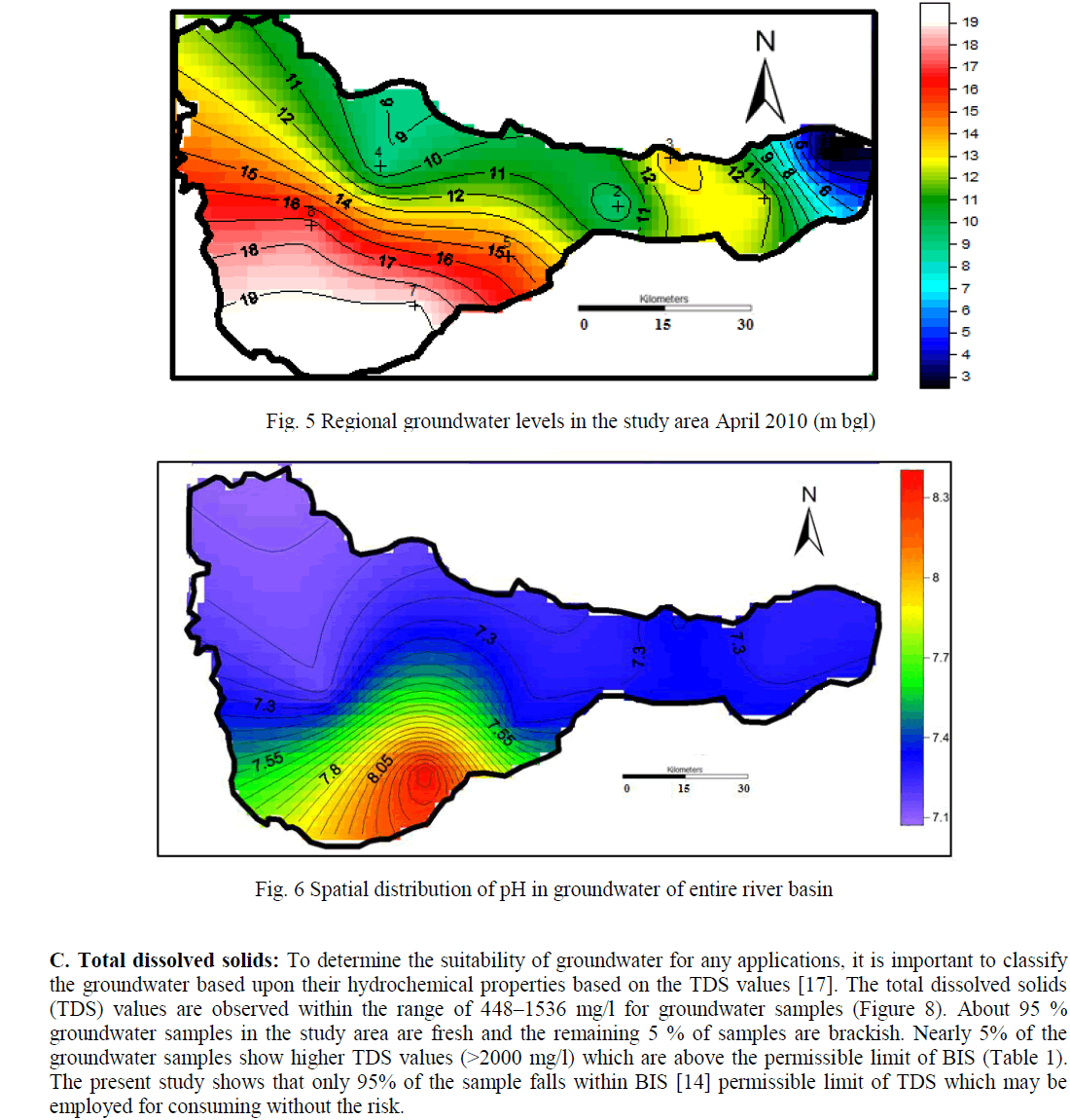 |
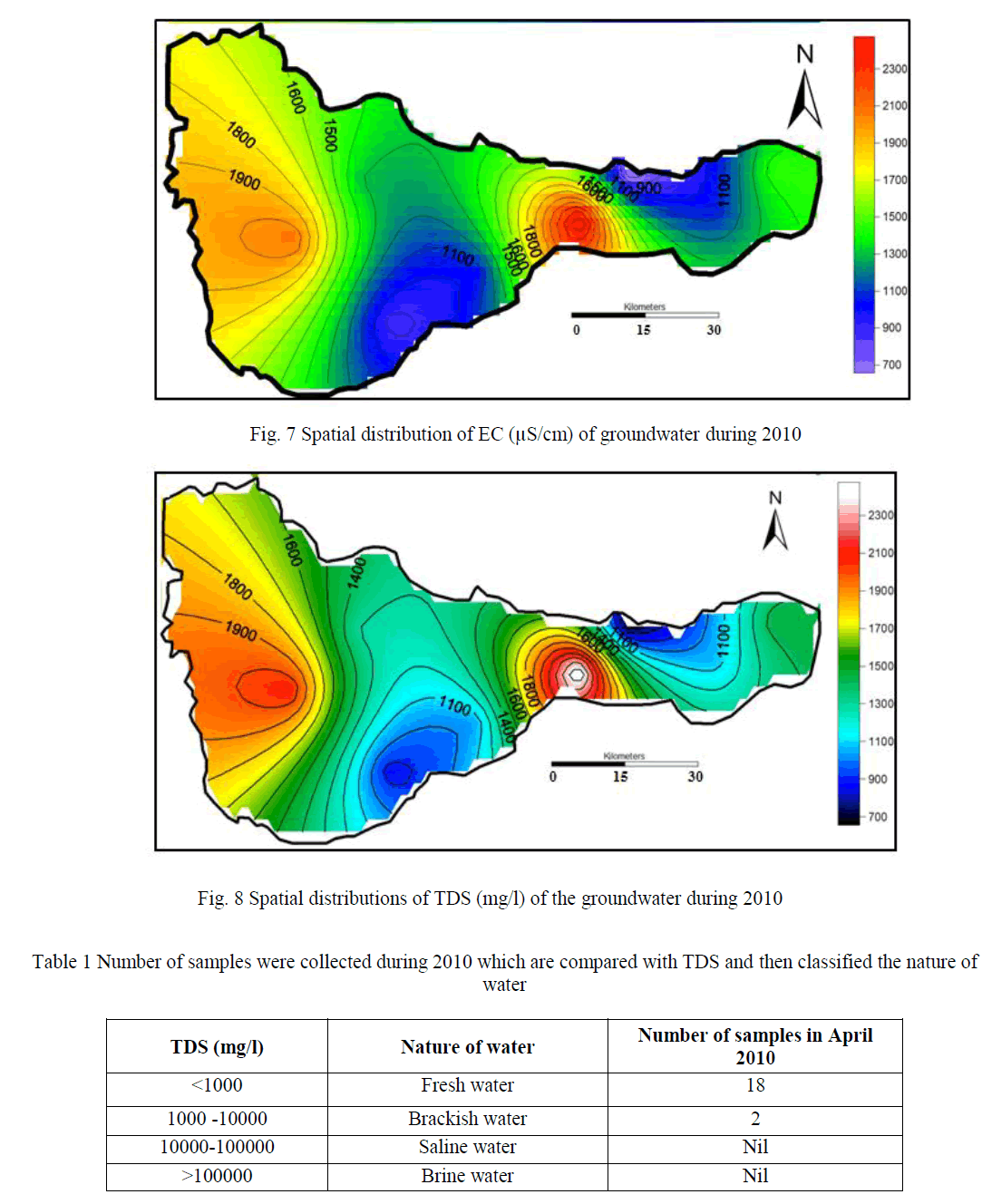 |
CONCLUSION |
| Groundwater in Kosasthalaiyar river basin is generally alkaline and fresh to brackish in nature. The principal economy of the region depends entirely on agriculture activities. This region is intensively cultivated by making use of groundwater from dug and bore wells. The study region is underline by Achaean crystalline rocks and sedimentary rocks. Clay, gneiss, laterite, sandstone are the major geology in this region. Geomorphologically most of the study region is covered by alluvial plain and pediplain. Groundwater level was measured for all the 20 wells. Groundwater level was fluctuated from 3 to 8m from surface. Most of the groundwater samples were alkaline nature. The EC ranges from 700 to 2,400 μS/cm. The present study shows that 95% of the sample falls within BIS (2012) permissible limit of TDS which may be employed for consuming without the risk. |
References |
|